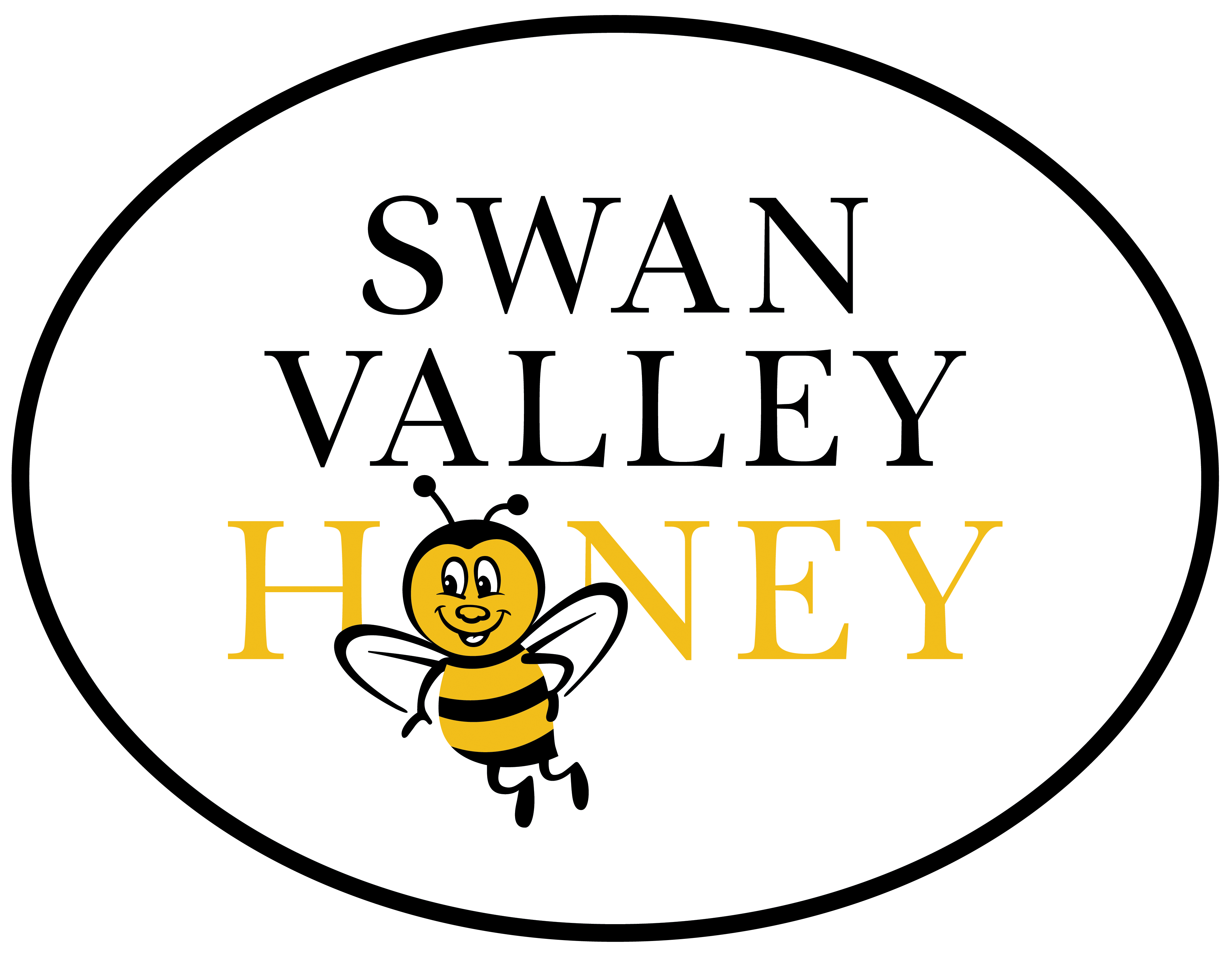Honey Purity Test Explained: How to Check If Honey Is Pure or Adulterated?
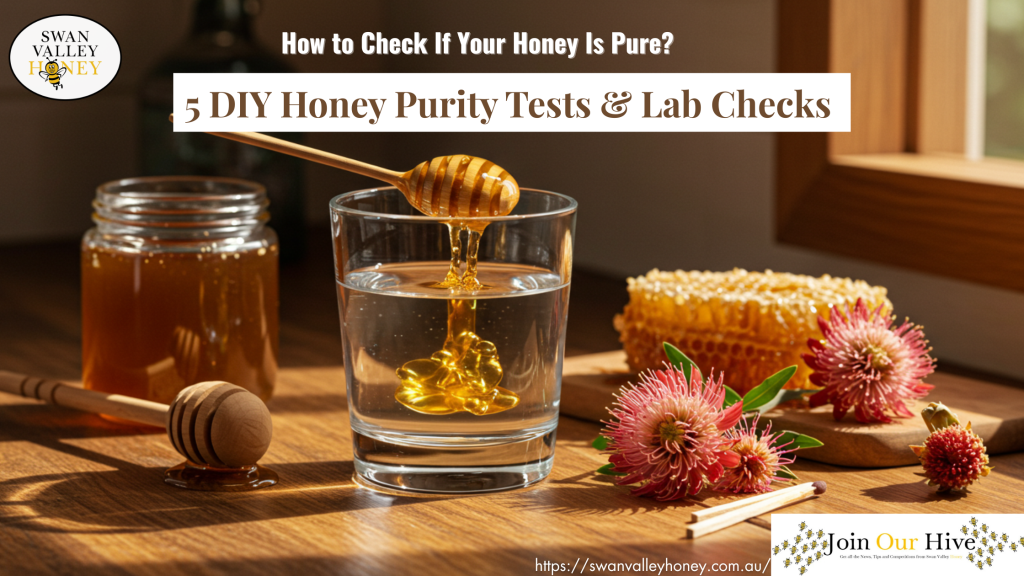
Honey is prized as a healthy alternative to sugar. But is your jar the real deal?
With honey laundering on the rise, it’s tough to know what’s in your jar. In fact, nearly half of global honey samples have been found diluted with cheap syrups. And unfortunately, even “natural” labels can’t always guarantee purity.
In this guide, we’ll walk you through 5 simple DIY honey purity tests and advanced lab methods to help you detect adulterated honey right in your kitchen or with special tools.
So, keep reading to explore how to test the purity of honey at home, avoid fake honey, and be confident in buying truly raw, premium honey in WA.
What is ‘Pure’ Honey?
Pure honey is the unaltered nectar of flowers, turned into honey by bees. It’s about 76–80% sugars (fructose & glucose) with only 17–20% water.
Pure honey also contains pollen, enzymes, antioxidants and trace minerals from the flowers.
In other words, it’s a rich, natural food. However, adulterated honey is honey diluted with syrups, extra waters and additives. It has lower nutritional value and may contain residues or allergens.
Why Test Honey for Purity?
Testing honey’s purity ensures you get all the benefits of pure or raw honey, from antioxidants to healthy enzymes, and avoid the hidden risks of fillers.
Over the past decade, the increasing demand of honey has driven up adulteration worldwide.
For example, Europe recently flagged 46% of honey samples as suspect (mixed with corn, beet or rice syrups). Cheap imports flood the market, masked as pure.
Testing at home and in labs helps verify claims like “raw Australian honey” or “single-origin”, and protects your health. After all, pure honey retains its antioxidants, trace minerals, and antibacterial compounds. Whereas, adulterated honey can contain antibiotic residues or harmful additives.
How Is Honey Adulterated? Common Adulteration Practices
Adulterators dilute or manipulate honey to increase profit while reducing quality. Here are the most common methods:
- Mixing with cheap sugar syrups, such as:
- High-fructose corn syrup (C4 sugar)
- Cane sugar or beet sugar (C3 sugars)
- Glucose or rice syrup
- Adding plain water to increase volume and weight
- Overheating the honey to improve flow or mask poor quality (this raises HMF levels)
- Filtering out pollen to hide the honey’s floral source and origin
- Blending raw honey with artificial honey made from invert sugar or starch syrup
- Using synthetic additives to mimic natural taste or colour
Because adulterated honey almost looks and pours like real honey, visual inspection isn’t enough. DIY tests and lab checks are your best tools for spotting fakes. Let’s go through them.
Part I: DIY Honey Purity Tests at Home
You don’t need fancy equipment to screen for fake honey. Here are five simple at-home tests. They’re not foolproof individually, but together they give a good indication.
1. Water Dissolution Test
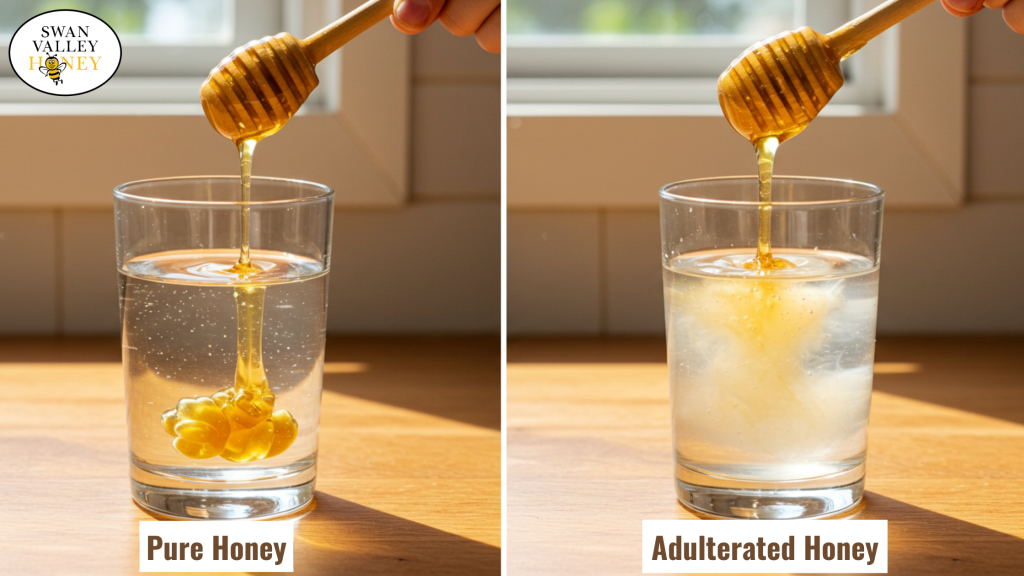
Fill a clear glass with water. Gently add a spoonful of honey. Do not stir. Pure honey will clump and sink slowly to the bottom. If the honey disperses and dissolves quickly in water, it suggests added water or syrups.
Interpretation: If the honey forms a solid lump, it’s likely pure. Whereas a cloud of honey indicates possible dilution.
Be cautious: an unripe (immature) but pure honey can dissolve more readily because it has higher moisture. Likewise, some thick adulterants (like rice syrup) might sink like real honey. So, treat this as a quick screen, not a guarantee.
Approx. time: 5 minutes.
2. Thumb/Drop Test
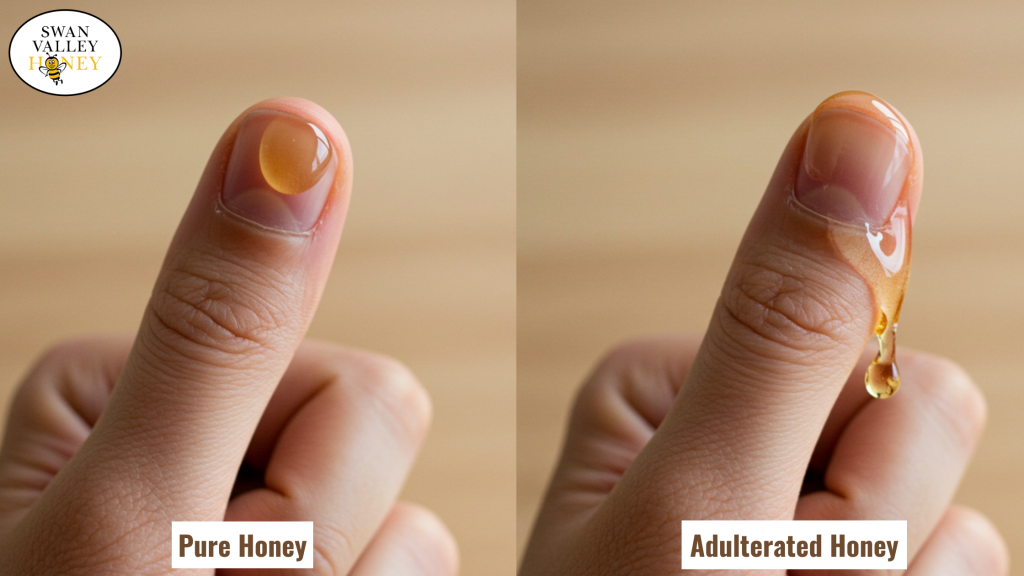
Clean and dry your finger. Place a drop of honey on your thumb or palm. Hold your hand horizontally.
Interpretation: Pure honey is viscous and sticky, so it shouldn’t quickly spread. Adulterated honey (with extra water/sugars) is more runny and will start to flow.
Approx. Time: Instant.
3. Flame & Heat Test

Flame test: Dip the tip of a matchstick or cotton bud in the honey, then try to light it.
Observation: Pure honey’s low moisture means the match can ignite and burn steadily. If the match won’t light, moisture or additives may be present.
Heat test: Put a teaspoon of honey in a metal spoon or small pan over low heat.
Observation: Pure honey will caramelise and darken but not foam. Adulterated honey bubbles, foams or leaves a soapy residue when heated, because of excess water or impurities.
Safety note: Be careful with open flames. Work near a sink or outdoors.
Approx. Time: 1–2 minutes.
4. Vinegar (Acid) Test
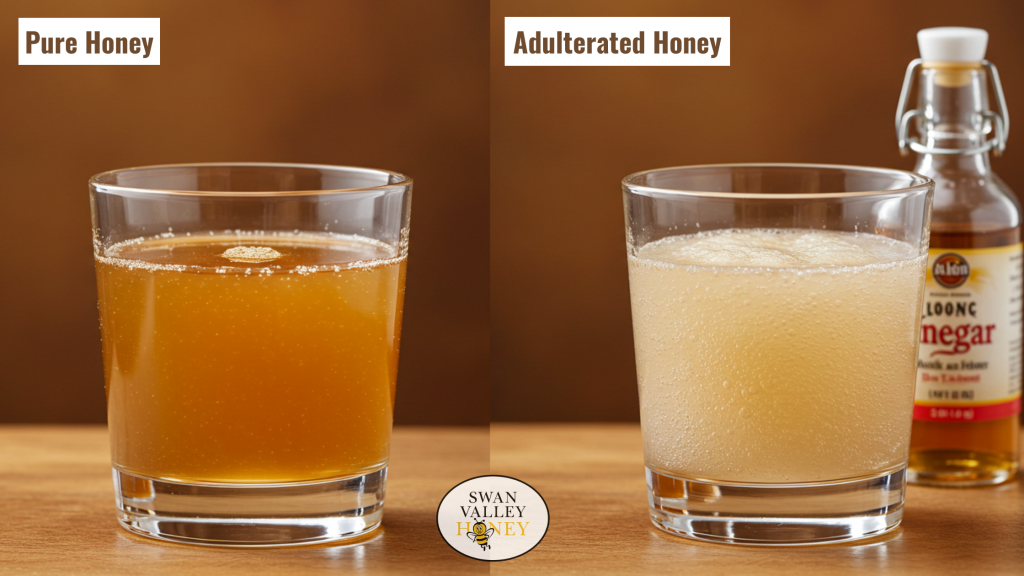
DIY pH indicator: Mix 2 tablespoons of honey in 1/4 cup of water; add 2–3 tablespoons of white vinegar. If the mixture foams or fizzes, it could signal adulteration.
Interpretation: Pure honey is slightly acidic (pH 3.9) so it usually won’t react vigorously with vinegar. Foam or fizz indicates the presence of alkaline substances or added agents neutralising the acid.
Approx. Time: 5 minutes.
5. Smell, Taste & Crystallisation
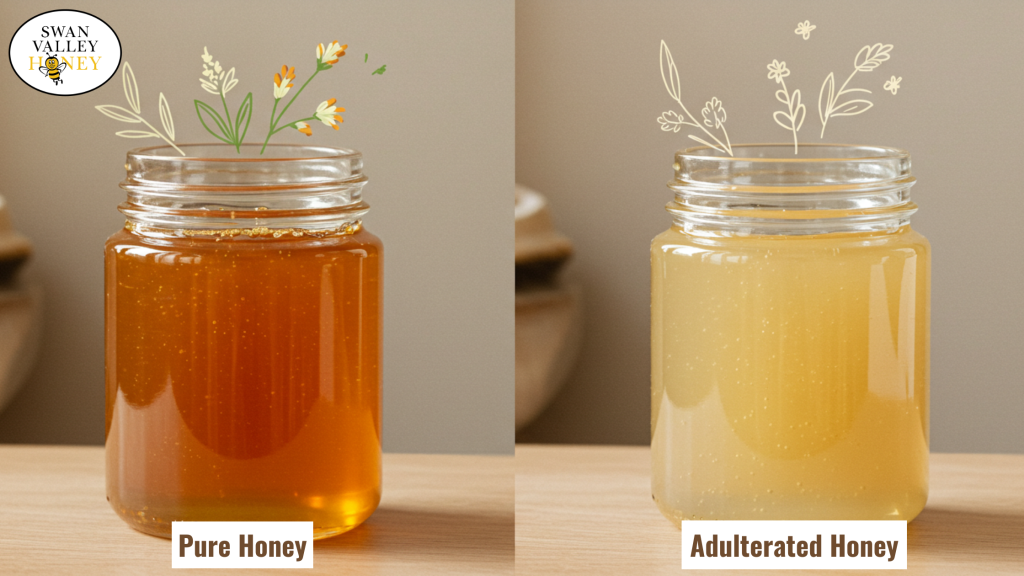
- Smell: Pure honey has a delicate, fragrant aroma hinting at its floral source (e.g. citrus, blossoms, or herbs).
Interpretation:
pleasant floral aroma = quality pure honey
no aroma or overly pungent smell = adulterated honey
- Taste: Genuine honey has a rich, multi-layered sweetness. It may have fruity, spicy or herbal notes beyond just sugar. Fake honey usually tastes cloyingly sweet and one-dimensional (syrup-like).
Interpretation:
complex taste = quality pure honey
overly sweet = adulterated honey
- Crystallisation: Most raw honeys crystallise (turn grainy or semi-solid) over time due to their natural glucose content. Finding crunchy or crystal honey is actually a good sign of purity. In contrast, ultra-processed honeys can stay perpetually liquid.
Interpretation:
natural crystallisation = quality pure honey
no crystals = adulterated honey
Note: some genuine honeys (like very high-fructose Jarrah) crystallise slowly, so lack of crystals doesn’t automatically mean impure. But rapid crystallisation strongly indicates real, unpasteurised honey.
Part II: Advanced Laboratory Tests to Check Honey Purity
For definitive results, professional labs use scientific methods. Here are the key analyses:
1. Pollen Analysis (Melissopalynology)
Lab specialists examine the pollen grains in honey under a microscope. The types and proportions of pollen reveal the floral origin of the nectar.
For example, true Jarrah honey should be rich in Eucalyptus marginata pollen, while Karri honey shows different pollen.
Pollen analysis can confirm single-origin claims. However, note that in biodiverse regions like Australia, bees may collect nectar from multiple plants and pollen can be uneven. Still, melissopalynology is a useful authenticity check, especially when combsined with other data.
2. Hydroxymethylfurfural (HMF) Levels
HMF is a compound that forms when honey’s sugars break down with heating or ageing. Fresh, pure honey has very low HMF. High levels suggest overheating or adulteration.
International standards (Codex) limit HMF to ≤40 mg/kg (or ≤80 mg/kg for tropical honeys).
Western Australian honeys are temperate, so keep HMF well under 40. For instance, good Swan Valley Jarrah has HMF around 10–20 mg/kg if fresh. This confirms freshness and proper handling. Whereas, a high number is a red flag.
3. Conductivity & Moisture Content
Electrical conductivity of honey correlates with mineral content. Most blossom honeys (non-honeydew) have conductivity ≤0.8 mS/cm. If a jar labeled as a floral honey has unusually high conductivity, it may be adulterated with honeydew or something odd.
Moisture is also measured: Codex allows ≤20% water in standard honeys.
High moisture not only dilutes honey but also risks fermentation. Labs use these simple physicochemical tests to check compliance; e.g. moisture above 20% or conductivity outside expected range may indicate tampering.
4. Total Activity (TA) & Antibacterial Strength
Some honeys (especially Jarrah and Karri) are prized for medicinal strength. The Total Activity (TA) rating measures overall antibacterial power (combining peroxide and non-peroxide effects). It’s expressed as a percentage equivalent of phenol. Manuka honey has the UMF/MGO rating, but for Australian honeys we use TA.
For example, a TA30+ rating means antibacterial strength like a 30% phenol solution.
Swan Valley’s Jarrah tests at TA30–50+, which is very high. Indeed, Jarrah’s antibacterial levels have been found to exceed those of Manuka honey. Testing TA ensures therapeutic-grade honeys are genuine.
5. Spectroscopy Methods
Advanced instruments can detect adulterants down to parts per million.
- LC-IRMS (liquid chromatography – isotope ratio mass spec) checks carbon isotope ratios to spot C4 syrups (cane/corn sugar).
- NMR spectroscopy provides a molecular “fingerprint” of honey, revealing any foreign sugars (C3 syrups, syrups, etc.) and even geographical signatures.
These advanced methods are used by official labs and honey regulators. Practically, NMR and LC-IRMS can catch sophisticated adulteration that home tests miss, though they’re expensive and require expertise.
Data Snapshot: Swan Valley Honey Lab Results
Below is an example of real lab data on Swan Valley samples (Jarrah, Redgum and Wildflower honeys):
| Sample | Type | Moisture (%) | HMF (mg/kg) | Conductivity (mS/cm) | TA (Phenol eq. %) |
| SVH-Jarrah-1 | Jarrah | 17.5 | 12 | 0.36 | 32 |
| SVH-Jarrah-2 | Jarrah | 16.8 | 9 | 0.40 | 35 |
| SVH-Jarrah-3 | Jarrah | 18.0 | 14 | 0.33 | 29 |
| SVH-Jarrah-4 | Jarrah | 17.2 | 8 | 0.38 | 34 |
| SVH-Redgum-1 | Redgum | 18.5 | 25 | 0.55 | 22 |
| SVH-Redgum-2 | Redgum | 19.0 | 30 | 0.58 | 20 |
| SVH-Wild-1 | Wildflower | 17.0 | 5 | 0.25 | 12 |
| SVH-Wild-2 | Wildflower | 16.5 | 10 | 0.22 | 10 |
Lab outcomes: All samples have moisture <20% (ok) and relatively low HMF. Note Jarrah’s TA 30–35%. Tis reflects its well-known antibacterial strength. Redgum (Marri) has moderate TA, and Wildflower is lower (since it’s a mixed floral blend).
What to Look for When Buying Pure Honey in Western Australia
To avoid fakes, become a label detective and question-asker:
- Labels:
Authentic honeys boast single-origin and raw claims. Look for phrases like “Raw Honey,” “Single-Origin,” “Unfiltered,” “Unheated,” or “Organic”.
These indicate minimal processing. Beware vague terms like “natural” or “premium”. They’re marketing fluff. A good label can also list harvest region or season e.g. WA Jarrah 2025.
- Quality Marks:
Check for official seals (organic certifications) or standardised ratings.
For example, some producers list a TA or MGO/UMF number, or note lab testing. Quality Australian honeys will state “100% Australian” and a batch number.
- Source Region:
Knowing where the honey is from is key. Truly pure Jarrah, Karri, or Redgum honey in Western Australia has specific taste profiles.
Ask if the honey is local or imported. Small local brands usually share details about hive locations and bloom dates. Large supermarket jars may just say “Product of Australia” without specifics, so be cautious.
- Producer Transparency:
The best sellers will happily answer questions. Read their FAQs or ask the seller: “Where were these bees kept? When was this honey harvested? Do you test each batch in a lab?”
Authentic beekeepers document seasonal hive movements. For WA honeys, you might hear “Jarrah flowering 2024/25 – we harvested in spring” or similar.
Swan Valley Honey’s Quality Assurance
At Swan Valley Honey, for example, we apply strict quality control.
- Every jar is from single floral sources and is 100% unfiltered and unheated.
- We place hives across WA’s Karri, Jarrah, Redgum and wildflower regions, rotating them seasonally to match bloom.
- We never use antibiotics or chemicals, and we only harvest when bees have surplus.
- Our claim is backed by testing: our award-winning Jarrah honey (TA30+) is lab-verified and even Guinness-recognised.
Such practices ensure the honey remains pure, safe and rich in real nutrition.
Buy 100% Pure Honey at Swan Valley Honey in WA
Enjoy genuine liquid gold that’s been tested and trusted.
Our flagship Jarrah Honey comes from Australia’s untouched forests, harvested only when nature allows, and packed with antibacterial TA30+ potency. With full lab testing and an unheated, single-flower process, we guarantee 100% Australian purity.
Don’t settle for diluted imitation – taste the real thing and support sustainable beekeeping.
FAQs
Q1: How do you know if honey is 100% pure?
Try simple tests:
- Heat Test: Pure honey caramelizes without foaming when heated.
- Flame Test: A match dipped in pure honey still lights.
- Water & Thumb Tests: Pure honey sinks in water and doesn’t spread on your thumb.
Q2: What’s the easiest way to check honey’s purity?
The Water Test is quick. Drop honey in water. Pure honey sinks, fake dissolves fast. You can also rub a drop between your fingers. Pure honey feels thick and sticky, not runny or slick.
Q3: What are the purity parameters of honey?
- Sugar content: 76–80%
- Moisture: ≤20%
- HMF: ≤40 mg/kg (≤80 mg/kg for tropical honeys)
- Proline: ≥180 mg/kg
- Should be free of added sugars and contaminants (Codex & FSSAI standards).
Q4: Why did my flame test fail but a lab test pass?
DIY tests aren’t always reliable. Pure honey may fail if it’s too moist or thick. Lab tests like NMR and isotope analysis offer accurate confirmation. A failed flame test doesn’t always mean adulteration.
Q5: Can crystallisation indicate purity?
Yes. Natural crystallisation means the honey is raw and unprocessed. However, some pure honeys crystallise slowly, so lack of crystals doesn’t always mean it’s fake.
Q6: How does floral seasonality affect test results?
Floral source and harvest season can change honey’s moisture, HMF, and pollen levels. For example, Jarrah honey, harvested biennially in WA, has a unique profile compared to spring wildflower honey.
Q7: Does honey expire?
No. Pure honey never spoils if stored properly. It may darken or crystallise but remains safe to eat indefinitely. Discard only if you notice mould or an off smell.
